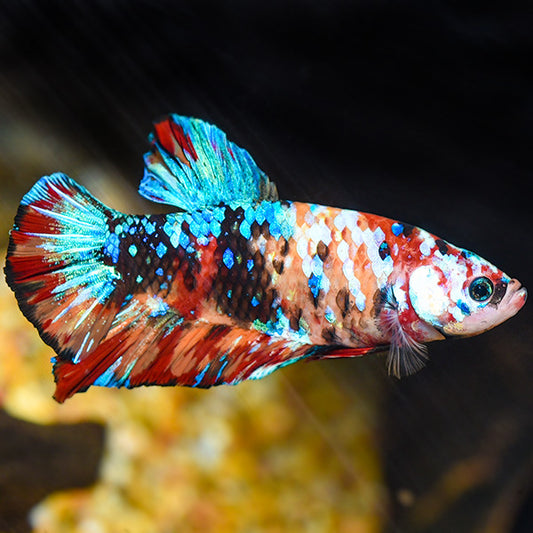Reproducing Betta Fish: a Comprehensive Step-By-Step Guide to Efficiently Raising Infant Bettas From Eggs to The Adult Years
Breeding Betta fish is a careful undertaking that needs cautious planning and implementation to guarantee the effective advancement of fry from eggs to mature fish. As the male Betta vigilantly constructs a bubble nest and guards the valuable eggs, the subsequent phases of care and change need attention to detail and expertise of finest methods.

Selecting Reproduction Pairs
When starting the journey of reproducing Betta fish, choosing the ideal breeding pairs is essential to achieving desirable characteristics and a healthy lineage - betta fish. The primary step in this procedure is to determine the specific traits you want to improve or protect, such as shade, fin kind, and body form. It is vital to select genetically varied pairs to prevent inbreeding, which can bring about wellness problems and undesirable attributes
Review prospective breeding candidates very carefully. A healthy and balanced male Betta needs to show vivid colors, an energetic attitude, and well-formed fins, while the lady must likewise show lively coloration and a rounded tummy, suggesting preparedness for spawning. Observing the personality of both fish is important, as hostile or excessively timid individuals might not breed effectively.
Maintaining records of the parent fish's ancestry can assist you track hereditary traits and potential problems. Eventually, spending time in the selection procedure will considerably improve the likelihood of creating solid, dynamic spawn that satisfy your breeding goals.

Preparing the Breeding Tank
Creating an optimum breeding setting is an essential step after picking suitable pairs for Betta fish. The breeding tank must be particularly developed to offer convenience and boost the natural breeding habits of the fish. Start with a tank size of at the very least 10 gallons to make certain ample space for both the man and women Bettas.
Preserve a gentle purification system to maintain the water clean while staying clear of solid currents that can worry the fish. In addition, an air rock can be included in offer oxygenation without interfering with the water surface area way too much.
Temperature law is important; go for a steady variety of 78-82 ° F(25-28 ° C) making use of a reliable heater. The pH degree need to be kept in between 6.5 and 7.5, and normal water modifications are needed to guarantee high water quality.
Include floating plants or generating mops to create hiding areas for the woman, while likewise encouraging bubble nest building by the man click this site - betta fish. Make sure the container is free from sharp designs and any type of possible threats, as the well-being of the fish ought to constantly be focused on during this vital stage of reproduction.
The Reproduction Refine
Commonly, the reproducing procedure for Betta fish entails a series of distinct and evident actions that show readiness for recreation. The male Betta begins by constructing a bubble nest at the water's surface area, which works as a site for the fed eggs. This nest is essential, as it provides a risk-free setting for the eggs until they hatch out.
Once the nest is developed, the male will show courtship habits, such as flaring his fins and showing lively colors to bring in the female. The woman, upon noticing the male's preparedness, will certainly respond by displaying vertical red stripes along her body, signaling her receptiveness.
The fertilized eggs after that drop to the bubble nest, where the male meticulously gathers and returns them to the nest. Following this, the male assumes responsibility for securing the nest and making certain the safety and security of the eggs up until they hatch, typically within 24-36 hours.
Caring for Betta Fry
Caring for Betta fry requires cautious attention to their environment and nutrition to guarantee healthy and balanced development and development. After hatching out, Betta fry are incredibly tiny and vulnerable, necessitating a secure and tidy habitat.
Feeding Betta fry is just as vital. Feed them small amounts a number of times a day, being careful not to overfeed, which can lead to water quality problems.
Transitioning to Grownup Bettas
As Betta fry fully grown, transitioning them to grown-up Bettas is a vital stage that calls for careful monitoring of their atmosphere and social interactions. This procedure generally begins when the fry get to around six weeks of age, whereupon they can be gradually introduced to a much more organized living setting.
To promote this change, it is vital to guarantee that the water parameters-- such as temperature level, pH, and ammonia levels-- are ideal and steady. Adult Betta fish flourish in cozy water (around 78-80 ° F) with a pH see it here of 6.5 to 7.5. Slowly adjust the fry to these conditions to reduce tension.
Social communications are another vital variable; man see it here Bettas are notoriously territorial and hostile. Consequently, it is advisable to different males into individual storage tanks as they develop. Women Bettas can be housed with each other, but care should be taken to monitor for indications of aggression.
Additionally, dietary adjustments need to be made as the fry expand. Integrate premium pellets and live foods to support their growth and health and wellness. By taking care of these aspects effectively, you can advertise a successful transition to adulthood for your Betta fish.

Final Thought
Successful reproduction of Betta fish needs cautious focus to information throughout the entire procedure, from choosing genetically diverse pairs to providing optimum treatment for fry. Furthermore, a well balanced diet plan and gradual adaptation to grown-up environments are important for the growth and advancement of Betta fish.